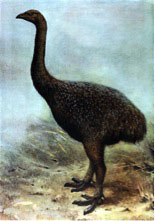Jurassic Park: Great Entertainment, Not Science
This year marks the twentieth anniversary of Steven Spielberg’s prehistoric blockbuster, Jurassic Park. Although the idea of coming face-to-teeth with dinosaurs thrills (and terrifies) many people, ancient DNA studies reveal that human-dinosaur interaction was and is limited to the realm of fantasy and science fiction.
When Jurassic Park first came to theatres in 1993, the idea that extinct creatures might someday be brought back to life fascinated me. Being a molecular biologist by trade, I knew the concept was theoretically possible, but, practically speaking, it was extremely difficult. In the 20 years since the movie’s release, scientists have learned much more about ancient DNA to help address whether dinosaur revivification is possible. Though the process is problematic, researchers have managed to extract and sequence DNA from some fossils. Additional research indicates that only extraordinarily well-preserved fossils (unlike those of the dinosaurs) can produce enough intact DNA to measure. The results of these ancient DNA studies hold implications for the age-of-the-earth discussion.
What happens to ancient DNA?
DNA is a relatively stable molecule compared to other information-carrying molecules (such as RNA). Even so, DNA degrades after an organism’s death because the DNA repair mechanisms no longer function and bacteria act to break down the body. Over time, the bonds between the nucleotide base pairs break, reducing the DNA to smaller and smaller fragments. When sequenced, ancient DNA can still produce short sequences from these fragments. And because multiple copies of DNA break at different locations, researchers can use cloned DNA copies to generate a complete, or nearly complete, sequence by overlapping multiple short sequences via computer analysis.
Prior to the development of the revolutionary polymerase chain reaction (PCR) in 1983, scientists had to clone DNA through bacteria in order to get enough genetic material to measure. However, PCR used DNA polymerase from thermophilic (heat-loving) bacteria to replicate the desired DNA in a very small tube within a machine called a thermal cycler (see image 1). These small machines are often used by forensic scientists and typically contain 96 holes (or wells) through which temperatures can be maintained for a defined period of time. In theory, a researcher could use one copy of DNA, along with DNA polymerase and a few chemicals, to generate billions of copies of the DNA, which could then be sequenced to determine its genetic composition. Thermal cyclers permit scientists to put 96, or even up to 384 samples (in larger machines), in at once, allowing for high throughput.

Image 1: Thermal Cycler
Image credit: Rich Deem
In 1984, scientists extracted ancient DNA for the first time; the source was a museum specimen of an extinct horse species. Since then, researchers have sequenced the DNA of many ancient animals, plants, and microorganisms. But the most exciting data comes from sequenced DNA from ancient humans and Neanderthal fossils. In 1997, researchers reported on Neanderthal mitochondrial DNA sequences and later, in 2010, on Neanderthal nuclear DNA sequences.1 Attempts to sequence DNA from hominids older than Neanderthals have been unsuccessful, presumably because the older fossils have had more time to decay. (For example, compare more than 300,000 years for Homo erectus to 60,000 years for Neanderthals). Fossil age (as well as preservation conditions) leads to questions about DNA’s stability over long periods of decay.
Determining DNA’s half-life
An inability to reliably reproduce conditions within fossils in the laboratory has hampered scientists’ attempts to measure DNA stability. However, researchers in New Zealand devised a way to measure the DNA from the moa, an extinct bird species (see image 2). Moa went extinct relatively recently; thus, the researchers were able to recover 158 fossils (carbon-14 dated between 600 and 8,000 years old) and measure the degradation of the birds’ DNA. In their study2 the team concluded that, when preserved at a temperature of 13°C (as in the case of the moa fossils), DNA has a half-life of 521 years
Image 2: Moa reconstruction
Image credit: Extinct Birds, Lionel Walter Rothschild, 1907, public domain.
This means that after 521 years at 13°C, half the bonds in a DNA sample will be degraded. After another 521 years, only 25 percent of the DNA will remain intact. And after 521 more years (or 1,563 total), only 12.5 percent and so on. However, since even a small fossil contains millions of cells (and the DNA they contain), intact DNA fragments can be isolated as long as the fossil is not too old. Researchers calculated that the DNA from frozen fossils would not completely fragment for 6.8 million years. (Although it’s likely that, just a little more than 1 million years after death, the fragments would have become too small to piece together).
Since the last dinosaur died 65 million years ago, it is clear that scientists will never be able to reconstruct even a partial DNA sequence for any “terrible lizard.” Alas, Jurassic Park will never happen in real life. The data also suggests that obtaining a DNA sequence from Homo erectus and earlier hominids will prove extremely difficult, due to the fossils’ more ancient age and adverse preservation conditions (being primarily located in hot or tropical regions).
Creation implications
These findings on DNA stability also allow scientists to test different creation models. If young-earth creationism is true, then dinosaur fossils should be only 4,000–6,000 years old. For this to be true, nearly 0.5 percent of dino DNA should be intact, making recovery of such genetic material––with today’s techniques––easy. Yet what we now know about the stability, or lack thereof, of ancient DNA indicates dinosaurs lived and died millions of years ago. Thus, the evidence weighs in favor of an old Earth.

Mr. Richard Deem received his MS in Medical Microbiology from California State University of Los Angeles in 1979 and currently serves as a research scientist at Cedars-Sinai Medical Center in Los Angeles.
Endnotes
- Richard E. Green et al., “A Draft Sequence of the Neandertal Genome,” Science 328 (May 7, 2010): 710–22.
- Morten E. Allentoft, “The Half-Life of DNA in Bone: Measuring Decay Kinetics in 158 Dated Fossils,” Proceedings of the Royal Society B 279 (December 2012): 4724–33.






